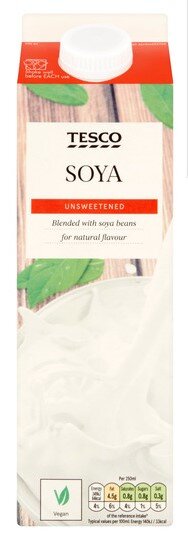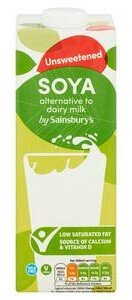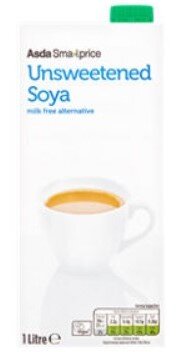Which milk and why?
Updated in December 2023
When we went dairy-free in 2008…
We used this for everything from tea to cereal but the dentist told me that the hidden sugars were causing de-enamelisation of my teeth, so we switched.
Which milks did we buy after that?
We decided to try each supermarket’s own brand of long life unsweetened soya milk. All of them were fine. They may have varied a little in price but for me, the aspect that mattered the most was the thickness of milk. I like making Indian tea and for that, I prefer milk that’s in-between full fat and semi-skimmed. So if it was too thin, I wasn’t happy with it.
These images don’t represent the ones we purchased back in 2008 or 2009 as the packaging was different.
After we decided which of the following milk was best in terms of thickness, when we needed to buy some, we would check the price in order of preference and then order about 20 or 30 cartons at a time. This meant that we would be hard-pressed to run out of milk!
Discovering rice milk
One day we decided to try rice milk. It’s not the one you see pictured on the left. They don’t seem to make that one anymore!
Anyway, it was delicious. We liked having it with cereal and drinking it on its own but not in tea.
Then, we tried this brown rice milk and I liked it even more than the white rice milk! It was so tasty but again, we didn’t like it in hot drinks. It was also a bit expensive and I wanted to make sure we didn’t have 2 cartons of milk open at the same time and for any to be wasted, so we stopped buying it.
Labels
We started looking at labels and realised that there were a lot of ‘extra’ ingredients in some of the milks we were buying. We decided to stick to this organic one which literally had about 3 ingredients in it.
Our fav!
This is what we use now. We love it in everything including cereal, porridge, tea, coffee and hot chocolate.
What about the environment?
There’s been a lot of talk about the impact of dairy and plant-based milk on the planet. The following image shows the environmental impact of one glass of milk.
As you can see, dairy is the worst offender in terms of emissions, land use and water use. Rice and Almond follow, where rice milk has a greater impact on emissions but almond milk used more water. When comparing Soy milk and Oat milk, Soy has a slightly greater impact on emissions and Oat’s use of water is a little more than Soy.
So it seems that Soy and Oat are better than Almond, Rice and Dairy when thinking about the planet.
So why has Soy Milk developed such a bad reputation?
Saying that, Soy milk became unpopular because of myths around hormones and that it was the cause of deforestation. The information below can be found in an article that was published in The Guardian.
Why is Soy milk unpopular?
The primary environmental drawback to soy milk is that soybeans are grown in massive quantities around the world to feed livestock for meat and dairy production. Large swaths of rainforest in the Amazon have been burned to make way for soy farms. The work-around for this is to simply do a little research and read the carton to find soy milk that is made from organic soybeans grown in the US or Canada.
The myth about how soy is used
“Soy is found in almost ALL commercially produced meat. The growing demand is destroying rainforests, as acres are cut down to make way for crops that we feed to animals. So next time you hear that vegans are responsible for deforestation because of soy, you know the truth!”
Isaac Emery, a food sustainability consultant, discusses Soy milk and hormones
“Soy has a relatively high concentration of certain hormones that are similar to human hormones and people got freaked out about that,” says Emery. “But the reality is you would have to consume an impossibly large amount of soy milk and tofu for that to ever be a problem.” Recent studies have instead found that a moderate amount of soy is healthy, especially for women.”
Anything's better than cows' milk
“What is beyond doubt is that – by any criteria - all four plant milks are significantly better for the environment than cows’ milk.
- Cows’ poop, belches and farts all release methane, contributing to the 3.2kg of CO2eq emissions produced when making 200ml cows’ milk.
- Land is needed to grow feed for cows, as well as to graze them, so 9m2 of land is needed for every 200ml of cows’ milk.
- Cows need to drink and be washed, and water is required to grow their feed, so it takes 628 litres of water for a 200ml glass of cows’ milk.
So, give yourself a little pat on the back the next time you’re in the plant milk aisle. You’re helping to keep your milk footprint nice and small.”
Other things to consider
I’ve become more aware of a few things recently.
several GPs have told their patients not to drink plant-based milk because their sugar level has increased. If this is true for you or anyone you know, you don’t need to return to dairy. Instead, try out the many unsweetened plant milks that are available.
Read the label and check whether the milk contains unnecessary ingredients. If so, check out a different brand.
Barista versions are very fatty so if you are conscious about your weight/fatty intake, or if you’re borderline obese, for example, having barista milk multiple times a day in your drinks or cereal is not a good idea
Related content
Almonds are out. Dairy is a disaster. So what milk should we drink?
Climate change: Which vegan milk is best?
Range of life-cycle CO2 emissions for different vehicle and fuel types
How much water do you use?
Veganuary: Is following a vegan diet for a month worth it?
Climate change: Failure to tackle warming 'suicidal'
Climate change food calculator: What's your diet's carbon footprint?
Climate change: Where we are in seven charts and what you can do to help
Soy: food, feed, and land use change
“People tend to underestimate the greenhouse gas emissions from food, and dairy milk is no exception, according to research by Dr Adrian Camilleri, a psychologist at the University of Technology Sydney.
”The greenhouse gas emissions from milk are about 30 times higher than what people estimate,” he told BBC News.
”I suspect that most consumers underestimate the greenhouse gas emissions saved by switching from dairy milk to plant-based milk such as soy milk.””













